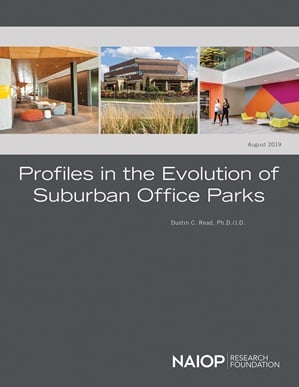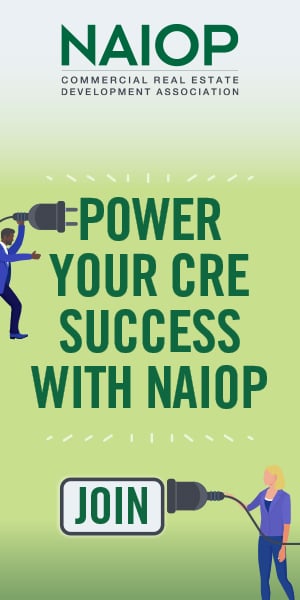Breathing New Life into Old Office Parks

By adding new uses and amenities, older properties can be remade into magnets for younger skilled workers.
The suburban office parks built in the 1980s and early 1990s were once desired, cost-efficient corporate destinations. But as skilled workers migrated to urban cores, corporate campuses lost favor.
However, a new trend in office demand has emerged as a growing share of skilled workers are now moving back to the suburbs in search of affordable housing and quality schools. This shift has renewed interest in redeveloping older office parks to attract a new generation of office workers.
The NAIOP Research Foundation has published a new report titled “Profiles in the Evolution of Suburban Office Parks,” by Dustin Read, Ph.D. Through five case studies, it examines how developers in the U.S. and Canada are modernizing older parks with new uses and amenities to attract new tenants and boost profitability.
Understanding the Appeal of Older Office Parks
The concentrated economic opportunities, dynamism and amenities in major cities have attracted younger skilled workers for a long time, but rising housing costs and commercial rental rates in recent years have made urban core areas less attractive to workers and employers. As millennials grow older and form families, the affordable housing and quality public schools that many suburbs offer become more appealing. However, many of these workers are accustomed to workplaces with amenities and proximity to transit and retail, and suburban office parks that offer similar conveniences are more likely to attract them.
The report reveals that a growing number of developers see older office parks as attractive opportunities for redevelopment. They are often able to add value to these properties by increasing densities, improving space utilization, and adding new uses and amenities. This is particularly true for buildings that previously served a single large tenant and office parks with large surface parking lots that exceed current parking requirements.
In cases where a property has sat vacant, developers often find that municipal officials are amenable to proposals that revitalize the property. Some older office parks are also located in markets with high barriers to entry for new development as the limits of urban development have expanded significantly since they were first built.
What Developers Need to Keep in Mind
While older office parks offer substantial opportunities for redevelopment, they also present significant risks. The report’s case profiles reveal the unique challenges that developers face with office park redevelopment.
For instance, a strong understanding of the area’s market conditions, demographics and the preferences of workers, employers and public officials is critical to a successful office park redevelopment project. When older office parks struggle to attract tenants, it is often because the design no longer meets local needs, or they do not offer adequate amenities. Market research can help developers identify which features and uses to include in a redeveloped property. Similarly, developers must cultivate an understanding of local officials’ priorities so that they can show how redevelopment will benefit the community and in turn obtain the entitlements needed for significant improvements.
While it is important to develop a comprehensive plan for repositioning a property prior to acquisition, these plans also need to be flexible enough to allow developers to adapt to unforeseen circumstances. Some of the profiled developers had to adjust their initial redevelopment plans to suit a new anchor tenant or to accommodate local officials’ expectations for the property. It is also not uncommon to encounter unexpected structural or environmental challenges when redeveloping an older building. Moreover, developers can adapt to unexpected challenges by actively seeking out lenders who will offer flexible loan terms that allow for significant changes to initial design plans and project timelines.
All the developers profiled in the report noted the importance of creating a new sense of place and a brand that was distinct from the original property. Developers can use design, technology and shared amenities to build a property’s sense of community. Rebranding a property to match its new uses and aesthetics also helps the surrounding community recognize a redeveloped property’s value.
Collectively, the report’s case profiles provide developers with a roadmap to locate and redevelop promising properties. They also suggest that office park redevelopment will remain an effective strategy for the foreseeable future.
Shawn Moura, Ph.D., is the director of research for NAIOP.





